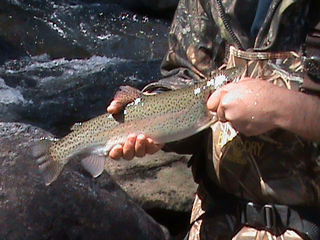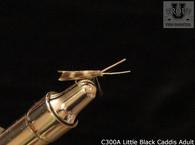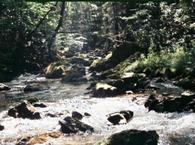The basics of fertile vs. infertile trout streams:
Geology determines the entire character of a trout stream. A glance at the surrounding terrain can tell you how big the trout will grow, how much food is available to them, and how they will be distributed in the stream; it also helps you predict their feeding behavior of trout and even what flies will work on trout. Trout streams are made from water and rock, or rock particles like sand and silt. The chemical composition of the water comes from compounds leached from surrounding rock. These compounds encourage or discourage the growth of algae, diatoms, insects, crustaceans, and rooted aquatic plants, which form the food chain that supports a trout population.
Calcium compounds, found in many sedimentary and metamorphic rocks, counteract acidity. The amount of biomass in a stream, particularly the pounds per acre of trout flesh, is directly related to the pH. The more bicarbonate in solution, the more acid is neutralized, and the higher the pH. The higher the pH, the more productive the trout stream. Calcium in solution is also suspected to benefit the physiology of trout directly. Apparently it helps the fish fight off toxins in the water. Plants can also pull a molecule of carbon dioxide directly off calcium bicarbonate in solution, so streams with high calcium content support more plant life. More plants mean more insects, and fatter trout.
Two minerals form the bulk of freshwater buffering systems: calcite and dolomite. Calcite is pure calcium carbonate, and dolomite is mostly calcium magnesium carbonate with various impurities.
Limestone is the most common source of these minerals, and the most productive trout streams in the world flow through limestone. You can spot limestone bedrock by its sedimentary layers and its brown or yellowish color.
Given smaller seasonal stability and runoff pattern, a "hard" water stream will be richer for trout than one with "soft" water. Any rock composed primarily of calcium or magnesium carbonate will leach into water, thereby "hardening" the water and giving you a richer trout stream.
Rich trout “hard water” streams have a steady, constant food supply for trout. At the height of the richness scale are spring creeks, which differ little throughout the world. Twelve months a year the trout feed on midge pupae, small Blue-Winged Olive nymphs, scuds, and sow bugs.
As a class tailwaters are the richest trout streams in the world. Dams, if they release water from the bottom of the reservoir above them, as most of the famous ones do, stabilize both flow and temperature by being miserly with spring runoff and doling it out throughout the summer. Floods are reduced, temperature extremes are moderated, and growth is easier. Nutrients are concentrated in the impoundments behind dams. Trout also benefit in tailwaters because plankton is washed directly into the rivers and eaten by insects and crustaceans. Natural streams have little plankton because it's hard to maintain a trout population if you keep getting washed downstream, so invertebrate life in tailwaters enjoys a tremendous bonanza found in few natural environments. This explains to some extent why the “
Hooch” is such an importan fishery in Atlanta.
Rocks composed mainly of silica contribute nothing to the productivity of a trout stream because they release no carbonates into the water. Silica rocks in streams can be recognized by their smooth, rounded shapes and crystalline structure. The ones you commonly see making up the beds of unproductive trout streams are gneiss,
sandstone, quartzite, and various forms of granite. These metamorphic rocks make up the stream bed and offer little enrichment because these rocks are mostly insoluble silica. The water is much the same as rainwater runoff — on the acidic side with little of the dissolved calcium found in richer streams. The stony, thin, acidic soil also encourages the growth of conifers, especially hemlock, which, as the early settlers of New England found, is a source of tannic acid. The water has the tea-stained look of tannin, which comes directly from the hemlocks and from humic acid formed in bogs by the decomposition of organic matter.
Think of the upland brooks or mountain trout streams you have fished like the bouldery kind common in South Carolina Mountains, North Carolina Mountains, and Tennessee Mountains. Infertile or “soft” water streams are usually smaller than larger rivers that run through wider valleys and pick up nutrients from rich bottomland sediments.
Seldom do I predict the richness of a trout stream solely by staring at the rocks. It's easier and more accurate to eyeball other clues in and around a trout stream and use the geology as one piece of the puzzle. For example, the color of the water can often be a dead giveaway to its richness. The tea-colored water so common in the North Carolina Mountains indicates an infertile trout stream, where trout will be small, slow-growing, and eager to take almost any fly pattern.
A Pennsylvania study of three soft water and three hard water trout streams with similar drainage patterns showed that trout's growth rate was directly related to specific conductivity, which is a measure of dissolved calcium and magnesium salts in the water. Another study, in England, proved that limestone stream trout have a much lower seasonal variation in diet than those from soft water streams, and they grow faster as a result.
Let's take a look at how rich trout streams “hard water” differ from less fertile “soft water” ones, and at some practical ideas that surface as a result. Assume for the time being that soft water streams are not as rich as hard water streams — you'll learn how you can eyeball the relative richness of trout streams. Exerpts from The Orvis Guide to Prospecting for Trout. by
Tom Rosenbauer.






